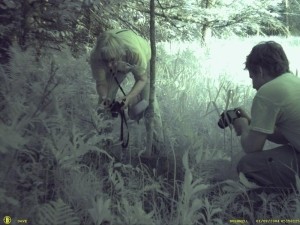Clouds – big suckers, with glorious mashed-potato tops and ominous sepia-toned bellies – trolled like battleships across Bahamian blue skies Wednesday afternoon. Back on earth, Ginny and I were traipsing through a lush hay field, talking about the award-winning nature photographs we were about to collect. You see, we’d put a game camera out by a fresh beaver carcass, which had been strategically placed by the remnants of a not-so-fresh moose carcass. Since it’s puppy season for foxes and coyotes, the cute little canids would undoubtedly be visiting the gore, and we were all set up to capture their images.
“Wait till Roger Irwin sees our fox puppy,” one of us exclaimed, a reference to the cover image on the summer issue of Northern Woodlands that should have showed up in your mailbox this week. “Teach me your tricks! he’ll say.”
We left the meadow and wove our way through a stand of white and red spruce, before dropping into a soggy depression where marsh marigolds and buttercups fought for elbow room with sensitive fern and sedges. As we approached the game-cam on the far side of the bog, we peeked to see if the beaver carcass was still there, then immediately stopped dead in our tracks. I think I said: “my good god.” VB, transfixed, let out a low whistle, unsheathed her camera, and started snapping.
You can see what we saw in the video and pictures below, and my apologies for my poor camera skills. What you’re looking at is a two-inch thick layer of squirming maggots being preyed upon by at least two kinds of carrion beetles and some rove beetles. The two easily recognizable beetles, the American carrion beetle (Necrophila americana), (that’s the one with a yellow pronotum) and the margined carrion beetle (Oiceoptoma noveboracense), the one with a red-margined pronotum, had produced scaly tapered larvae and together with their parents, the young ones were feeding from the base of the roiling mass of maggots. Of course, maggots compete with beetles for the beaver’s corpse, so it makes a kind of sense to devour them. The maggot population, however, was overwhelming. The beaver carcass appeared to have produced a volume of living matter that was larger than the source. And what a model of exponential growth and population collapse; certainly not all emerging flies and beetles find a bonanza like this.
I’m awful at teasing out larger meanings from novel experiences, but the moral here seems to be that while it’s easy for humans to become tunnel-visioned on the cover images in nature, there’s a world of cool animal life out there that doesn’t look like our dog. How funny to overlook the fact that insects comprise 90 percent of animal life on earth and not see this coming.
We shot a bunch of pictures, then took down our game-cam and made our leave. I’d later see that the only creatures the remote camera captured were two humans, squatting like deranged hominids out of a Cormac McCarthy novel around a writhing lump of rotting flesh.
“I figure hundreds of thousands of insects on one beaver is a pretty good return on our carrion investment,” said Virginia as we slogged back through the bog. I’m sure she was right. Sure, too, that neither one of us should quit our day jobs and get into nature photography.




